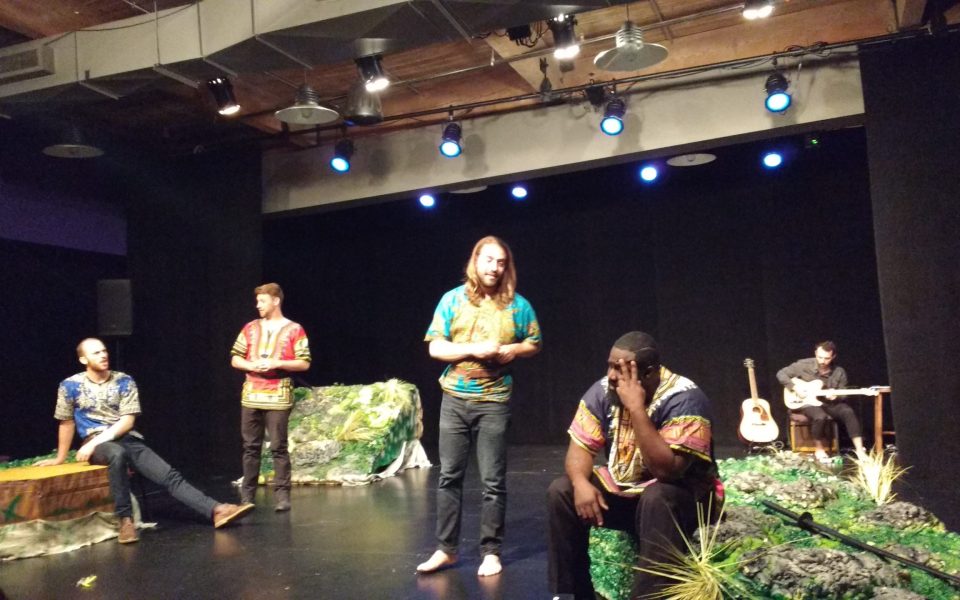For class reunions at most other colleges, people tailgate at a homecoming game, firing up some brats on a grill and swapping old stories. UNC School of the Arts alumni would rather reinvent Shakespeare.
In its inaugural performance of The Tempest: A Modern Retelling, Rhinoleap Productions reunites collegiate acting amigos now scattered primarily around New York City, forming a company of mostly UNCSA graduates whose aim is the experimental reinterpretation of classical and contemporary theatrical works.
For a school locally thought of to be a launching pad for the talented into a diaspora, it’s both heartwarming and obvious that to recombine those scattered talents outside of school would equal success. Its debut revealed that their reunion is nothing short of magical.
At a recent preview at the Milton Rhodes Arts Center, though a small audience of 20 barely populated the spacious theater, the cast’s high energy propelled the evening forward. Disposing of traditional doublets and the play’s likely multiple-hour-long run time, director Patrick Philip Osteen (Class of 2011) instead served up a Tempest-lite in 90 minutes, using puppetry and original music to abridge the original play without shaving off any of the story’s strength or character. Some of the script had also been updated with modern language, but it flowed seamlessly.
Widely rumored to be Shakespeare’s last original play, The Tempest is a curious choice for Rhinoleap’s debut, as one of the few Shakespearian works that happens in real time instead of over several days or years. The written-in urgency was strengthened by the actors’ unified high level of energy — a sign of strong cast collaboration and effective directing.
One of Rhinoleap’s other companywide strengths that sets it apart from other myriad small-budgeted funky Shakespeare spinoffs is the members’ mastery of movement. To make the magic of an island ruled by a powerful magician believable requires unwavering commitment to the story’s reality. Moments between the wizard Prospero magically controlling and directing his spirit servant Ariel are remarkably convincing.
Remarkable, because the spirit of Ariel was portrayed as a soccer ball-sized globe on a dowel with a sheet draped over it, with a few stray glue-gun hairs trailing in its wake. At first, the idea of accepting this floating ghost-on-a-stick, manipulated and voiced with musical lyricism by the delightful Patrick Nolin, required a reality adjustment, but Nolin’s dedication to his puppet eventually made this easy.
His choice to depict the trapped spirit as cheerfully acquiescing added some much-needed levity to Prospero’s moody rule of the island.
The character, usually interpreted as a “goodly” magician compared to his island nemesis, Sycorax, is widely believed to be a representation of the Bard himself; Alex Hoeffler injected gravitas, a slight melancholy undertone, and a touch of crazy eyes to his take on the wizard.
Unnecessary semi-English accent notwithstanding, Hoeffler’s flawless mastery of the tricky script proved a verbal anchor for the play, as he serves as both narrator and master of the plot. It’s slightly unfair, given that Prospero gets all the best lines (“We are such stuff/ As dreams are made on, and our little life/ Is rounded with a sleep”) but Hoeffler earned the right to deliver them.
Adam Levinthal’s take on Prospero’s other servant, the tortured and mean-hearted Caliban, is a successful marriage of his natural talent and some next-level puppet design by Aaron Haskell and AchesonWalsh Studios in New York City.
To play the monster, Levinthal crouched low to the ground within a nasty-looking shroud of burlap and weeds, holding a beaky, feathered mask in his right hand, which glowed eerily under blacklighting. Though a relatively scary character, he is absolutely pitiful; even a row of kids in the audience couldn’t help but laugh when Levinthal manipulated Caliban’s “head” to jerk and hiss in a failed attempt of a threat.
The set design by Scott Nicholson used blacklighting and shadow puppetry to transition between scenes or to quickly mime what takes pages of verse in the script to tell.
One such scene at the very end of the play spoke to incredible directing by Osteen.
After a whole play’s length of teasing Ariel with freedom, in the original script, Prospero grants him his freedom almost as an afterthought in a stage aside right before the epilogue. Rhinoleap’s interpretation instead used blacklighting to illuminate the spirit’s form pressed up against a long stretch of shimmering white cloth, as if trapped in air itself, as Prospero’s huge glowing mask representing his magic releases him at last from his servitude.
Sequences like that are what make modern retellings of old plays truly thrilling. It will be exciting to see what Rhinoleap reinvents next.
Join the First Amendment Society, a membership that goes directly to funding TCB‘s newsroom.
We believe that reporting can save the world.
The TCB First Amendment Society recognizes the vital role of a free, unfettered press with a bundling of local experiences designed to build community, and unique engagements with our newsroom that will help you understand, and shape, local journalism’s critical role in uplifting the people in our cities.
All revenue goes directly into the newsroom as reporters’ salaries and freelance commissions.


Leave a Reply